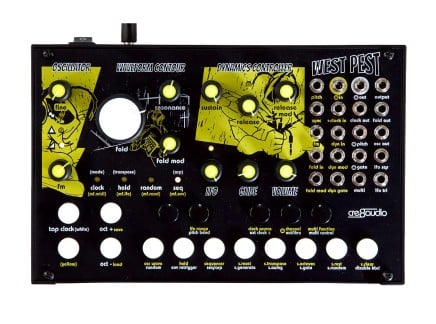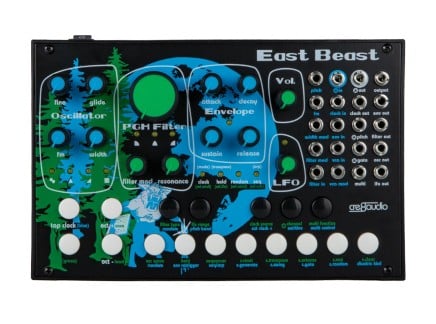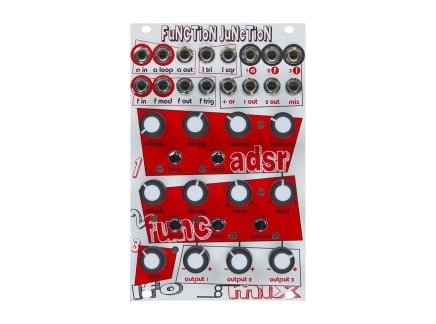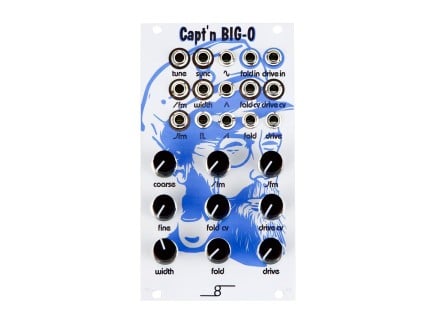Hot off the release of the East Beast, Cre8audio and Pittsburgh Modular are back with the West Pest. Much as the former was an ode to subtractive stylings of East Coast synthesis, this new semi-modular synth aims to occupy a similar sonic space as famous West Coast instruments, specifically those originally designed by Don Buchla. But like the East Beast, West Pest is perhaps the most affordable and accessible way to get your hands on these sounds.
If you want to learn more about its classic subtractive sibling, check out our review of the East Beast—but if you're here for the skronks, bonks, bongos, and wavefolders, read on.
West Pest's Origin Story
It's clear that West Pest is an immediate continuation of the semi-modular synthesizer line that began with East Beast. In our previous articles on West Coast synthesis and the East Beast, we've covered both the history and defining traits of the West Coast philosophy as well as the established partnership of Cre8audio and Pittsburgh Modular, so we won't waste time revisiting familiar territory here. Instead, let's jump right into what's special about the West Pest.

West Pest similarly draws from a few of the stellar instruments and modules that Pitsburgh Modular has put out over the years. Where the East Beast built upon the SV-1, West Pest instead picks up from where the Voltage Research Laboratory left off. A favorite for many of us here at Perfect Circuit in the short time it was around, the VRL was a dense analog synthesizer which put complex sound design opportunities under tactile control. Itself being a decidedly West Coast-inspired instrument, several components of the Voltage Research Lab were given a new lease on life as part of the West Pest, especially the Dynamics Controller. Add in the approachable interface and flexible digital control options, and West Pest just might be the piece of gear that some curious minds and adventurous ears have been looking for.
Inside the West Pest
Remember that West Pest is semi-modular, meaning that while it does have patch points to explore, you don't need to crack open your pack of cables to get started. There's a pre-defined signal path that allows you to make sounds right out of the box, but it's through patching that more complex timbres will emerge and the true spirit of West Coast synthesis is revealed.
Like most synthesizers, West Pest begins with a simple oscillator, upon which bold sounds are later built. This fully analog oscillator offers sine, triangle, and sawtooth waveshapes—with combinations available—as well as the ability to apply control voltages for pitch, sync, and frequency modulation. From there, the first taste of West Coast sound is heard immediately with the Waveform Contour section. Contrasting with the filter found on East Beast, which removes harmonics from a waveform, West Pest instead contains a wavefolder—folding a wave back onto itself to generate harmonics through brute force reshaping of the signal. This design can apply up to six folds, with a CV input available for dynamic movement.
Another element typically associated with West Coast synthesis is the beloved lowpass gate, and while West Pest doesn't explicitly offer one, it does cover this functionality in its Dynamics Controller. Like an LPG, the Dynamics Controller functions like a filter and VCA rolled into one circuit, where louder sounds will also contain more high-frequency content in a way that loosely correlates with real-world sounds. Though unlike legacy LPG designs, there's no vactrol to be found in the West Pest, instead opting for a more sculptable approach over its sustain and decay when fed a trigger or gate signal.
To round things up, West Pest also contains a handy LFO, accessible button keyboard, and a powerful digital brain offering sequencing, multi-mode control voltage sources, MIDI-CV conversion, and more. This way, Cre8audio feels that by pairing this more abstract sound with an accessible control scheme, West Pest might appeal to those who have been turned off by the historically far out controller designs seen on West Coast instruments. It's also housed in the same sort of enclosure as East Beast, meaning the two will look great on a desk together. Likewise, West Pest is easily removed from said housing to be mounted in a Eurorack case as a 40hp module—neat!
West Pest is Best
While East Beast and West Pest represent seemingly opposing paradigms of synthesis, at the end of the day they both actually complement each other pretty well. One of the magical things about contemporary synthesizers like these is that they're designed with interconnectivity in mind. Throw a subtractive synth voice through the Dynamics Controller or shape the rich harmonics of the wavefolder with an ADSR envelope generator. The sky is the limit with how these two can be combined—not to mention the other fantastic modules made by Cre8audio and the hundreds of other Eurorack companies out there. But one thing's for certain: West Pest is sure to find a home in a whole bunch of studios.











